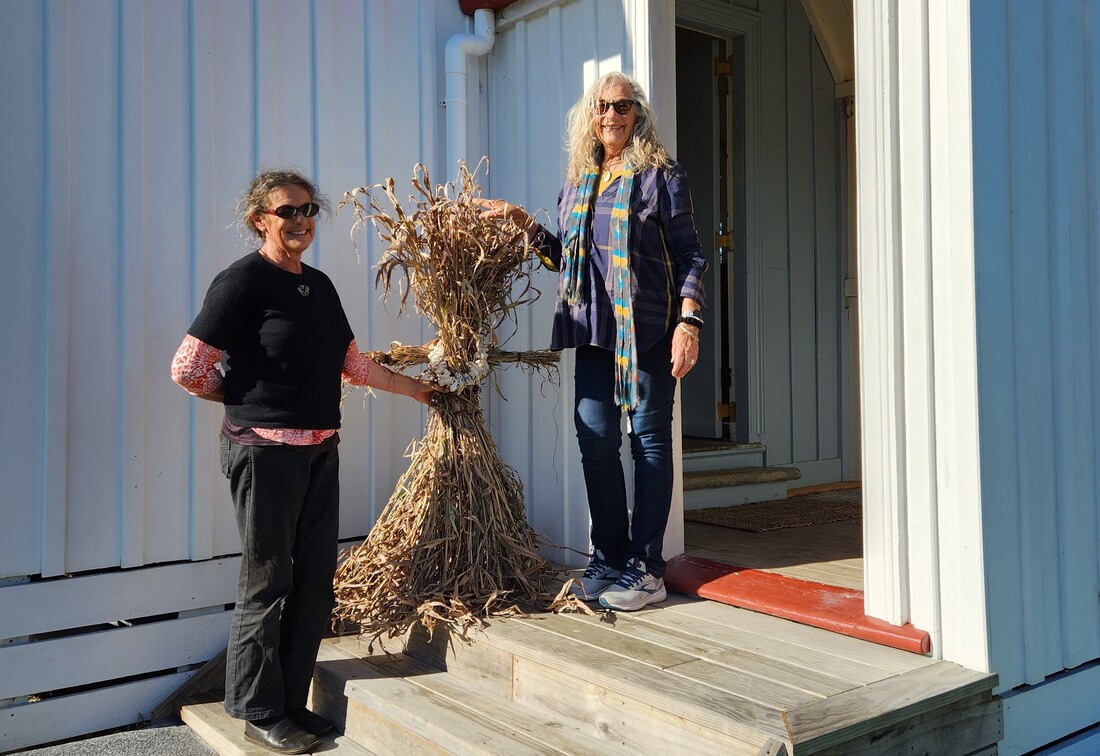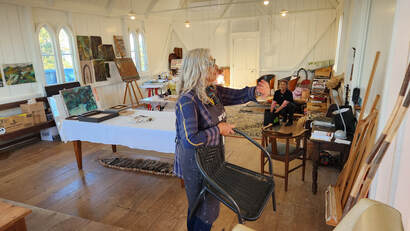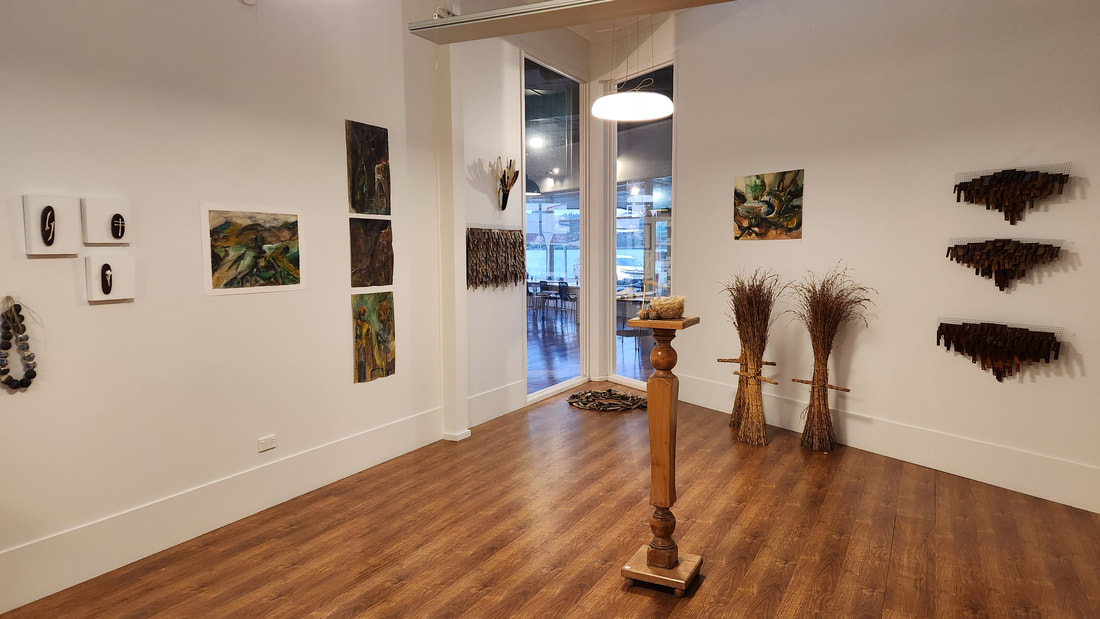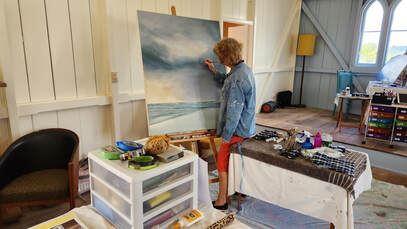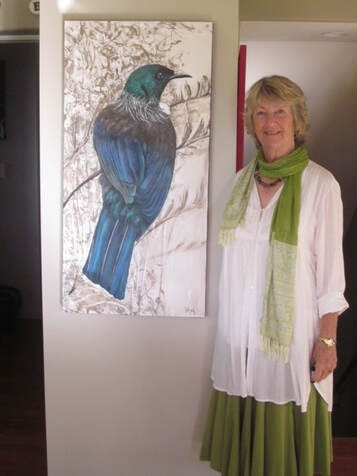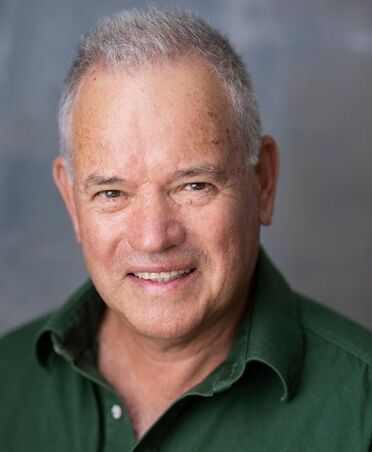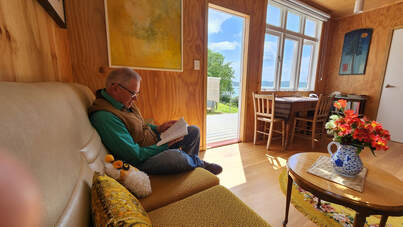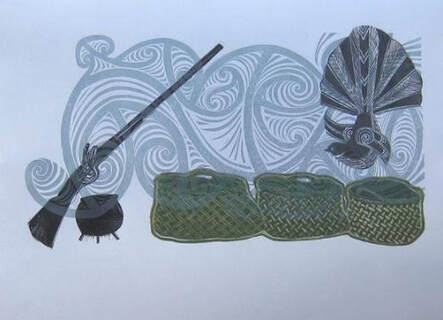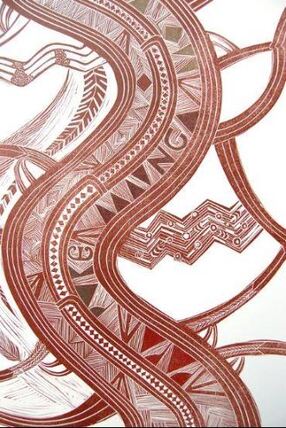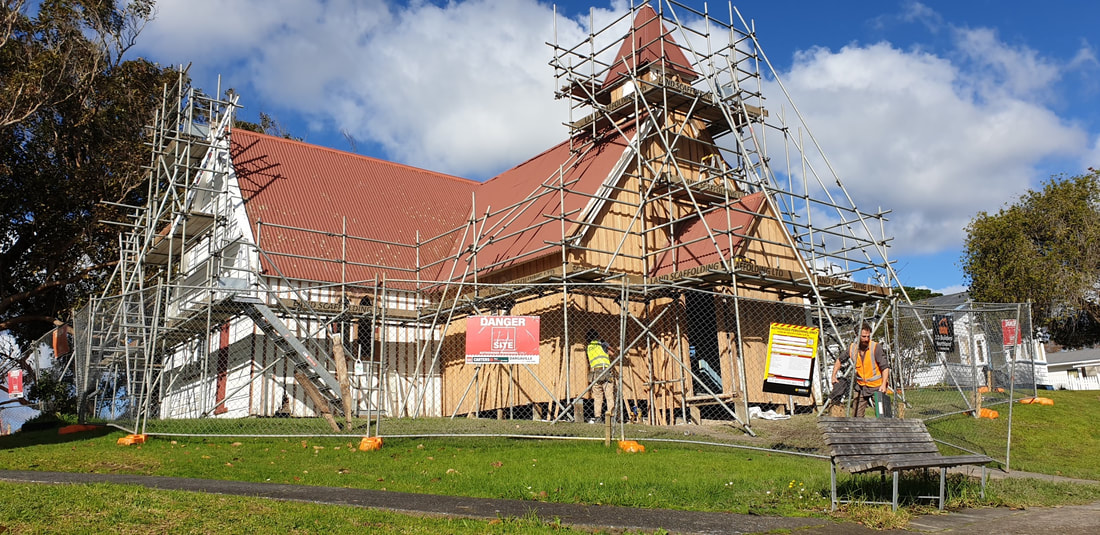The Church Rawene
Menu
Current and Past Residencies
Current Residency
Garth Maxwell
Returns for his third residency 8 July to 10 Aug
Returns for his third residency 8 July to 10 Aug
Previous Residencies
Greg Hall
18 June to 7 July
18 June to 7 July

I am a frequent vistor to the Hokianga and regard it as a unique place of mystery and inspiration. In 2017, I published my first novel, 'Good Sons', about three boys from Oamaru who get caught up in WW1. I have referenced the Hokianga in 'Good Sons' when Frank and his mates are in Wellington at the end of 1916 prior to embarking for the war. They come across two Maori boys from the Hokianga in a pub. The two are emabarking with the 12th Maori contingent. The names of the two were taken from the nominal role of the 12th Maori contingent and were real people. One of them, Puru Barber survived the war and is buried at Maungamuka. I have been to his grave.
At the end of the novel, the protagonist, Frank Wilson deserts from the New Zealand army after the battle of Passchendaele (Bellevue Spur) on 12 October 1917. He remains in France with a french woman and their child. In order to complete Frank's story it is entirely up to me to write it. I currently have a 95,000 word Manuscript with a working title 'A Larger Life', which supplies the answer to the question 'So, what did happen to Frank?' The novel is set in early 2000's at the turn of the century and I am currently rewriting it in the 3rd person and need a concentrated period of time to complete the work.
Reflections and Learnings
In June, the morning mists over the Hokianga seen through the cathedral windows of the church remind me of a writer’s blank page. As the day unfolds the beauty of the Hokianga is gradually revealed and my blank page takes shape in words and meaning and colour. In the footsteps of many others I entered the spiritual world of the Hokianga in June of 2024 and immersed myself in this original and genuine Rawene church residency experience.
‘Authentic’ may be an overused word but in this context, it richly describes the entire setting of the residency, the Hokianga, the church, Rawene and its people. The restoration of the church as a refuge for artists of all kinds was the brainchild of Linda and Lynn. The setting in the small town on the edge of the Hokianga is magic. The accommodation is brilliantly spare, complete and comfortable and the work space in the body of the church a large open area. I set up my desk on what I suppose was the chancel, with a view through the twin cathedral windows to the Hokianga itself.
I loved the isolation and the opportunity to immerse myself in my writing project. When I wanted a break, I walked the two-and-a-half-kilometre circuit that took me through Rawene, perhaps stopping for a coffee at the New Era café, perhaps a chat with someone in the gallery or any passerby, then on past the Boatshed and Te Ara Manawa o Rawene and eventually back to the church, my personal sanctuary.
When I needed a day off a visit to Omapere was attractive and to Mitimiti, a must. The last resting place of Bishop Pompallier, a walk on one the most heavenly beaches on God’s earth and a brief stop at the grave of Hone Papita Raukura "Ralph" Hotere an essential part of the Hokianga pilgrimage.
In the first week I wrestled with a part of my novel that had troubled me for years and finally found the courage to cull large sections and make necessary rewrites. I accomplished all that I set out to do in my shortened three-week residency and returned with a completed manuscript. I would go back at the drop of a proverbial hat.
At the end of the novel, the protagonist, Frank Wilson deserts from the New Zealand army after the battle of Passchendaele (Bellevue Spur) on 12 October 1917. He remains in France with a french woman and their child. In order to complete Frank's story it is entirely up to me to write it. I currently have a 95,000 word Manuscript with a working title 'A Larger Life', which supplies the answer to the question 'So, what did happen to Frank?' The novel is set in early 2000's at the turn of the century and I am currently rewriting it in the 3rd person and need a concentrated period of time to complete the work.
Reflections and Learnings
In June, the morning mists over the Hokianga seen through the cathedral windows of the church remind me of a writer’s blank page. As the day unfolds the beauty of the Hokianga is gradually revealed and my blank page takes shape in words and meaning and colour. In the footsteps of many others I entered the spiritual world of the Hokianga in June of 2024 and immersed myself in this original and genuine Rawene church residency experience.
‘Authentic’ may be an overused word but in this context, it richly describes the entire setting of the residency, the Hokianga, the church, Rawene and its people. The restoration of the church as a refuge for artists of all kinds was the brainchild of Linda and Lynn. The setting in the small town on the edge of the Hokianga is magic. The accommodation is brilliantly spare, complete and comfortable and the work space in the body of the church a large open area. I set up my desk on what I suppose was the chancel, with a view through the twin cathedral windows to the Hokianga itself.
I loved the isolation and the opportunity to immerse myself in my writing project. When I wanted a break, I walked the two-and-a-half-kilometre circuit that took me through Rawene, perhaps stopping for a coffee at the New Era café, perhaps a chat with someone in the gallery or any passerby, then on past the Boatshed and Te Ara Manawa o Rawene and eventually back to the church, my personal sanctuary.
When I needed a day off a visit to Omapere was attractive and to Mitimiti, a must. The last resting place of Bishop Pompallier, a walk on one the most heavenly beaches on God’s earth and a brief stop at the grave of Hone Papita Raukura "Ralph" Hotere an essential part of the Hokianga pilgrimage.
In the first week I wrestled with a part of my novel that had troubled me for years and finally found the courage to cull large sections and make necessary rewrites. I accomplished all that I set out to do in my shortened three-week residency and returned with a completed manuscript. I would go back at the drop of a proverbial hat.
Susan Dey
22 April to 16 June 2024
22 April to 16 June 2024

I studied art at school but didn't take it any further once I started working. I returned to my art practice in 2013 after completing the Level 5 Diploma of Art & Creativity (part-time) through The Learning Connexion. I've always wanted to do a residency but never had the time while working full-time. In 2022 I finished work to have more time to lead a creative life. This residency would enable me to immerse myself in my practice without distraction and to focus on producing a body of work. I envisage this residency would be very meaningful for me and life-changing in terms of my practice. The setting appeals to me because of the beauty of the landscape. I also feel a sense of affinity with the Hokianga through a historical family connection. I last visited Rawene in 2018 with my father
before he passed away at aged 90. As we were leaving he turned to me and said "I can imagine you painting here one day".
I want to further explore how a change in landscape and different light influences my painting. Immersion in the landscape will also enable me to explore how a sense of place and connection influences my work. I plan to do quite a bit of outdoor painting so I can be out and about to connect with people in the community. While I usually work in watercolour I want to explore combining pastels in my work. I will keep a journal as I want to develop my creative process in a way that establishes a rythym/routine to my art practice that I can sustain once I return home.
I have a past association with the Hokianga. Through my paternal grandmother Alice Emily White (1890-1951) I am related to Reverend William White (1794-1875) who was superintendent of the Wesleyan Mission Station at Mangungu. William's brother Francis (1799-1877) emigrated with his family in 1834 and settled on land adjacent to the mission station known as Te Mata. Francis is my great-great-great grandfather. I was raised in a Methodist family and grew up with stories about William and Francis White, and their sister Mary who joined them.

Reflections and Learnings
I began painting at Mangungu Mission Station where my great-great-great grandfather and his family arrived in the 1830s. From there I explored and sketched places in the Hokianga I had read about in family letters and diaries. I was inspired by the land and waterscapes as the light, weather and water changed. Everywhere I looked I saw a painting. My sense of connection with the Hokianga strengthened as I stayed in The Church, meeting people and getting to know Rawene.
The Church was a calm and peaceful space to develop my sketches into paintings. Having uninterrupted time and being fully immersed in my art practice really made a difference. I extended my skills and confidence with watercolour and achieved far more than I expected to. I am really happy with the paintings I produced during my residency.
I was grateful to be able to share my work through having an exhibition. Talking with visitors to the gallery and listening to their response to my artwork and the stories they told of the places I have painted was very special for me.
The whole experience of being in the Hokianga, living in Rawene and working in The Church has had a significant impact on my art practice. Lynn Lawton and Linda Blincko had a great vision when they established the artist’s residency and I thank them for their support and encouragement.
I began painting at Mangungu Mission Station where my great-great-great grandfather and his family arrived in the 1830s. From there I explored and sketched places in the Hokianga I had read about in family letters and diaries. I was inspired by the land and waterscapes as the light, weather and water changed. Everywhere I looked I saw a painting. My sense of connection with the Hokianga strengthened as I stayed in The Church, meeting people and getting to know Rawene.
The Church was a calm and peaceful space to develop my sketches into paintings. Having uninterrupted time and being fully immersed in my art practice really made a difference. I extended my skills and confidence with watercolour and achieved far more than I expected to. I am really happy with the paintings I produced during my residency.
I was grateful to be able to share my work through having an exhibition. Talking with visitors to the gallery and listening to their response to my artwork and the stories they told of the places I have painted was very special for me.
The whole experience of being in the Hokianga, living in Rawene and working in The Church has had a significant impact on my art practice. Lynn Lawton and Linda Blincko had a great vision when they established the artist’s residency and I thank them for their support and encouragement.
Maureen Lander
25 February to 20 April 2024
25 February to 20 April 2024
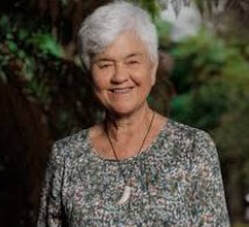
Maureen Lander MNZM born in Rawene, is a New Zealand weaver, multimedia installation artist and academic. Lander is of Ngāpuhi (Te Hikutu subtribe) and Pākehā (New Zealand European) descent and is a well-respected and significant artist who since 1986 has exhibited, photographed, written and taught Māori art. She continues to produce and exhibit work as well as attend residencies and symposia both nationally and internationally.
She received a Bachelor of Fine Arts in 1984, a Bachelor of Arts in Māori Studies in 1989, followed by a Master of Fine Arts in 1993, all from the University of Auckland. In 2002, she graduated with a Doctor of Fine Arts and received a Te Tohu Toi Ururangi award in recognition of academic excellence. From the early 1990s until 2007, she was a senior lecturer in Māori Studies at the University of Auckland, teaching in Māori material culture.
Lander has exhibited, photographed, lectured and written about Māori art since 1986. Her sculpture and installations draw inspiration from woven fibre, as well as Māori textiles held in museum collections. In 2019, Lander received a Ngā Tohu ā Tā Kingi Ihaka award from Te Waka Toi in recognition of her lifetime contribution to Māori art and culture.
https://www.tvnz.co.nz/shows/pathfinders/episodes/s2-e4
She received a Bachelor of Fine Arts in 1984, a Bachelor of Arts in Māori Studies in 1989, followed by a Master of Fine Arts in 1993, all from the University of Auckland. In 2002, she graduated with a Doctor of Fine Arts and received a Te Tohu Toi Ururangi award in recognition of academic excellence. From the early 1990s until 2007, she was a senior lecturer in Māori Studies at the University of Auckland, teaching in Māori material culture.
Lander has exhibited, photographed, lectured and written about Māori art since 1986. Her sculpture and installations draw inspiration from woven fibre, as well as Māori textiles held in museum collections. In 2019, Lander received a Ngā Tohu ā Tā Kingi Ihaka award from Te Waka Toi in recognition of her lifetime contribution to Māori art and culture.
https://www.tvnz.co.nz/shows/pathfinders/episodes/s2-e4

Reflections and Learnings
When people ask me if I enjoyed my Rawene Church residency I reply that I loved every minute of it. Here’s why:
Place. Rawene is a very special small town and for me the residency was an opportunity to return to the place where I was born. My mother grew up in Kohukohu and I have early memories and strong whakapapa links into Hokianga, even though I had never actually grew up there or lived in Rawene.
The community. A few days after I arrived, there was a two-day Waiata Festival and Rawene was buzzing. I caught up with lots of friends and family, setting the scene for numerous visitors during my eight weeks residency as people called in to see me in the church. They came bearing flowers, food and small gifts and were a highlight of my stay there. I felt re-connected to something very central to my soul, embraced by the place itself and by the people who live there.
The views. From the deck, the vistas across to the Narrows and up the reach of the Waima river were gentler than my views when I lived in Omapere looking out to the Hokianga Heads – more green/ silver than blue/gold, with rising mists, intriguing cloud formations and mirrored water, sometimes activated by a small flotilla of children’s yachts sailing past below. The light was constantly changing, with highlights of rainbows and reflected sunsets. I watched kotare diving for skinks amongst the nasturtiums flowering down the bank and soon adjusted to the rhythm of the Kohu Ra Tuarua ferry as it moved hour by half hour backwards and forwards between Rawene and the Narrows, counting down the days.
The church interior. This was an installation artist’s dream space. I loved the whiteness, the paired windows, the floor-space, the ceiling height and especially the rafters. I soon figured out how to throw a long cord (tied to a sock with a rubber ball inside) through one of the high up crossed rafters and then devised a pulley system to raise and lower my korari and muka installation work as it slowly progressed over time. Both the exterior and interior architecture helped create a sense of the old wooden building’s original purpose as a place of worship, evoking spiritual connotations around elements of my installations, especially the suspended floating muka that moved in the slightest breeze when the door was open indicating the presence of ‘hau’ from Tāwhirimātea.
Highlights:
When people ask me if I enjoyed my Rawene Church residency I reply that I loved every minute of it. Here’s why:
Place. Rawene is a very special small town and for me the residency was an opportunity to return to the place where I was born. My mother grew up in Kohukohu and I have early memories and strong whakapapa links into Hokianga, even though I had never actually grew up there or lived in Rawene.
The community. A few days after I arrived, there was a two-day Waiata Festival and Rawene was buzzing. I caught up with lots of friends and family, setting the scene for numerous visitors during my eight weeks residency as people called in to see me in the church. They came bearing flowers, food and small gifts and were a highlight of my stay there. I felt re-connected to something very central to my soul, embraced by the place itself and by the people who live there.
The views. From the deck, the vistas across to the Narrows and up the reach of the Waima river were gentler than my views when I lived in Omapere looking out to the Hokianga Heads – more green/ silver than blue/gold, with rising mists, intriguing cloud formations and mirrored water, sometimes activated by a small flotilla of children’s yachts sailing past below. The light was constantly changing, with highlights of rainbows and reflected sunsets. I watched kotare diving for skinks amongst the nasturtiums flowering down the bank and soon adjusted to the rhythm of the Kohu Ra Tuarua ferry as it moved hour by half hour backwards and forwards between Rawene and the Narrows, counting down the days.
The church interior. This was an installation artist’s dream space. I loved the whiteness, the paired windows, the floor-space, the ceiling height and especially the rafters. I soon figured out how to throw a long cord (tied to a sock with a rubber ball inside) through one of the high up crossed rafters and then devised a pulley system to raise and lower my korari and muka installation work as it slowly progressed over time. Both the exterior and interior architecture helped create a sense of the old wooden building’s original purpose as a place of worship, evoking spiritual connotations around elements of my installations, especially the suspended floating muka that moved in the slightest breeze when the door was open indicating the presence of ‘hau’ from Tāwhirimātea.
Highlights:
- Walking the track up on Te Ramaroa with Mandy Sunlight identifying plants for dye use.
- The TRRR trial sailing of our prototype Rā (Māori sail) on Will Ngakuru’s recently finished waka launched on the Waimamaku river – a huge success, leading up to a pending trial of our woven sail, Māhere Tū ki te Rangi in the near future.
- Preparing weaving materials with Mandy and working alongside weavers in the church and in Kaitaia on our collaborative project “He Kete Iti” (in conjunction with Auckland Museum).
- Learning about AI art-making with Stephen, and about garden plant dyes with Barbara from Kohukohu.
- Qigong sessions with Mike on Saturday mornings to help me maintain my balance, successfully tested on a great walk up, through and over the Wairere Boulders with Denise.
- Conversations with my many visitors, especially Claire, Janine, Wikitoria, Lorrie, Marg and others who all enriched my understanding of Hokianga and it’s colourful history. From these kōrero an idea emerged, yet to be realised, to embroider a unique map on the red Hudson Bay 4-point trade blanket I had brought with me as the basis for a possible project. I may need to return to the church in the future to research this idea and bring it to fruition.
- I especially enjoyed having time to experiment with installation ideas inspired by the architecture of the church and its surroundings - the light, water, mist, cloud forms etc seen through the windows and from the deck. Some of the people who visited gave me feedback on their interpretations of my suspended pieces and we had some fascinating kōrero as part of this process, adding thought-provoking perceptions for me to consider.
Ana Iti
8 January to 24 February
8 January to 24 February
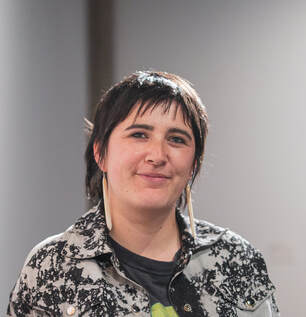
I am a full-time artist, which is both a challenge and a privilege. When I think about what being an artist is, I like this quote by Keri Hulme: “I am not a traveller, but I make journeys. The journeys are undertaken timidly, warily, with a sense of foreboding and coming despair. This is strange because I am overtly a hearty well-fed clown. Art is a way of thinking about things. For me, I get to take things apart and think about the different components of form, material and history and what I would like to explore and question.
This residency comes for me at a pivotal time. I will be working on a project for the Walters Prize exhibition at Auckland Art Gallery Toi o Tāmaki which recognises my contribution to contemporary art over the past three years. The work I have been making during this time explores relationships between transformation, tension and knowledge. I see the residency at The Church Rawene as an important opportunity to spend time in Northland, an area which I have whakapapa to but where I haven’t yet had the chance to spend a concentrated period of time. I am excited to be making work for the prize in a place that has a lot of significance for me personally. I believe this will give me further scope to expand on my research areas and to connect with the region, which has been a long term goal for me not only in my personal life but in my work as an artist. I am planning to create a series of modular sculptures based on the cast concrete piles that support the platform of the Rawene wharf, and which also incorporate what I am currently referring to as “contact surfaces”. I am also intending to make a sound work which could incorporate spoken word, and field recordings taken in Rawene.
This residency comes for me at a pivotal time. I will be working on a project for the Walters Prize exhibition at Auckland Art Gallery Toi o Tāmaki which recognises my contribution to contemporary art over the past three years. The work I have been making during this time explores relationships between transformation, tension and knowledge. I see the residency at The Church Rawene as an important opportunity to spend time in Northland, an area which I have whakapapa to but where I haven’t yet had the chance to spend a concentrated period of time. I am excited to be making work for the prize in a place that has a lot of significance for me personally. I believe this will give me further scope to expand on my research areas and to connect with the region, which has been a long term goal for me not only in my personal life but in my work as an artist. I am planning to create a series of modular sculptures based on the cast concrete piles that support the platform of the Rawene wharf, and which also incorporate what I am currently referring to as “contact surfaces”. I am also intending to make a sound work which could incorporate spoken word, and field recordings taken in Rawene.
Laura Donkers
31 Oct to 3 December 2023
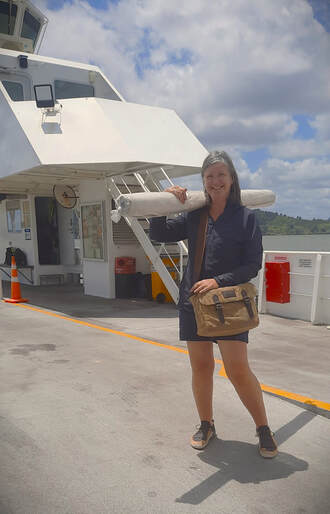
As an ecological artist-curator-researcher, I believe that art can have a significant impact on how we perceive the living environment. I think that perceptions of the climate crisis can be changed through creativity and co-production. I help people get closer to their communities and environments through social interactions and creative encounters in nature. I collaborate with artists, activists, communities and stakeholder organisations to create events, exhibitions and projects that explore the interplay between ecological concern and the embodied process. My multi-faceted practice engages with liminal spaces such as coastlines, salt marshes, mangroves and woodlands, and the people who exist on, move within and observe those spaces. Art-making activities help to raise ecological awareness through direct sensory experiences, experiential learning and new modes of creative activity, with the aim of putting people back in touch with environment, community, and self. “
When we do not have the words to say something, drawing can define both the real and unreal in visual terms” (Kovats, 2007: p. 8). The Hokianga Community Drawing Project proposes to engage the communities of Hokianga in a timely exchange about the impact of climate change on their everyday lives. From Opononi and Rawene to Kohukohu, Mitimiti and Mangamuka, this project will connect communities north and south of the Hokianga ferry link using a novel, collaborative drawing approach to talk about and express the experiences of living in the Hokianga at a time of climate change. The process of looking, seeing and viewing enables us to interpret experiences visually, emotionally and aesthetically.
When we do not have the words to say something, drawing can define both the real and unreal in visual terms” (Kovats, 2007: p. 8). The Hokianga Community Drawing Project proposes to engage the communities of Hokianga in a timely exchange about the impact of climate change on their everyday lives. From Opononi and Rawene to Kohukohu, Mitimiti and Mangamuka, this project will connect communities north and south of the Hokianga ferry link using a novel, collaborative drawing approach to talk about and express the experiences of living in the Hokianga at a time of climate change. The process of looking, seeing and viewing enables us to interpret experiences visually, emotionally and aesthetically.
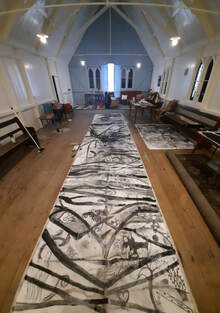
Reflections and Learnings
The Hokianga Community Drawing Project invited the communities of north and south Hokianga to make their mark on a large canvas (7.5x1.6m) with mānawa (mangrove) charcoal. This work sought expression from the different communities about their lives in the Hokianga at a time of climate change and formed part of my artist residency. I want to thank all the amazing creative people I met in Rawene and Kohukohu for adding their marks to the wonderful drawing we created together. I came with an ambitious plan of involving many people in the creative act of drawing and over the weeks I discovered the language, rhythm and approach that resonated with the people I met. Hokianga life has a gentle pace and a welcoming smile that allowed me to take my time to settle in, look around and become familiar with the weather changes, ferry timetable and daily human patterns. The challenge to instigate a collaboration gave me some sleepless nights but as I came to talk about it and share the process, the possibilities for its creation unfolded and my role as an interlocutor (conversation maker) developed. It became a joyful experience for everyone who took part, joined in the conversations or facilitated the creation - especially Tina and Mark who invited the project to the 'Whaea on Fire' women's health event, Lynn and your lovely volunteers Libby, Graeme and Mary at No 1 Gallery, Lynne and Marg at Village Arts, Eddy and Ada at the New Era Cafe, the kind ferry staff on the Kohu Ra Tuarua vehicle ferry, Glad from Tautoko FM and everyone who interacted, shared images on social media and supported this venture. It was an amazing way to spend my residency in Hokianga. I will keep you posted on where the drawing will get shown and the possibilities for finding a permanent home for it.
The Hokianga Community Drawing Project invited the communities of north and south Hokianga to make their mark on a large canvas (7.5x1.6m) with mānawa (mangrove) charcoal. This work sought expression from the different communities about their lives in the Hokianga at a time of climate change and formed part of my artist residency. I want to thank all the amazing creative people I met in Rawene and Kohukohu for adding their marks to the wonderful drawing we created together. I came with an ambitious plan of involving many people in the creative act of drawing and over the weeks I discovered the language, rhythm and approach that resonated with the people I met. Hokianga life has a gentle pace and a welcoming smile that allowed me to take my time to settle in, look around and become familiar with the weather changes, ferry timetable and daily human patterns. The challenge to instigate a collaboration gave me some sleepless nights but as I came to talk about it and share the process, the possibilities for its creation unfolded and my role as an interlocutor (conversation maker) developed. It became a joyful experience for everyone who took part, joined in the conversations or facilitated the creation - especially Tina and Mark who invited the project to the 'Whaea on Fire' women's health event, Lynn and your lovely volunteers Libby, Graeme and Mary at No 1 Gallery, Lynne and Marg at Village Arts, Eddy and Ada at the New Era Cafe, the kind ferry staff on the Kohu Ra Tuarua vehicle ferry, Glad from Tautoko FM and everyone who interacted, shared images on social media and supported this venture. It was an amazing way to spend my residency in Hokianga. I will keep you posted on where the drawing will get shown and the possibilities for finding a permanent home for it.
Fiona Cable
30 September to 29 October 2023
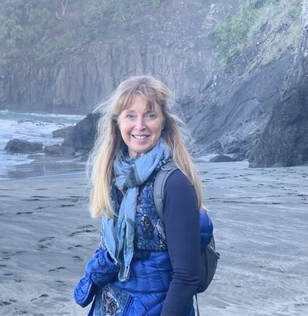
For most of human history, the world was enchanted and humans saw themselves as an integral part of it. The complete reverse of this perception in a mere four hundred years or so has destroyed the continuity of the human experience and the integrity of human psyche. It has nearly wrecked the planet as well. The only hope lies in a re enchantment of the world. (Morris Berman, The Re enchantment of the World).
Hokianga has been deeply affected by European settlement – in particular deforestation of Kauri forests, with the impact still being felt in many ways today. Long-term ecological, social, and historical impacts of industrialization and the western mechanical approach to ‘unliving’ are evident everywhere. Can an artist aid in the re echantment of a small part of the world? It makes my heart sink, a challenge almost too enormous to contemplate – yet to do something is better than nothing at all.
While researching regenerative agriculture, I decided to utilise my art practice as a way of note taking. By mending, sewing, dyeing, layered textured collages in an organic and instinctive way – this contemplative approach cements my learning in keeping with a sense of wonder. It takes longer, but the doing allows time for thinking and processing, taking hold in my mind, while the tactile, physical aspect means it is more embedded and integrated in a bodily way. Using the local natural environment as an extension of the studio, and in collaboration with the landscape, I intend to either create a land-based artwork – in the form of a mini food forest, or sculptural piece, in conjunction with textile-based artworks. A hanging piece stitched and felted, or both. Possibly an artist’s book illustrated with descriptions of local flora, of what is currently there and could potentially be there. It could include what I plant in the garden, preferably requiring minimal care by future artists with space in the book to be updated, notes or observations of their own to be added. The intention is to mend, sew and learn, creating new understandings of what it means to care for the environment in relation to the local area.
Hokianga has been deeply affected by European settlement – in particular deforestation of Kauri forests, with the impact still being felt in many ways today. Long-term ecological, social, and historical impacts of industrialization and the western mechanical approach to ‘unliving’ are evident everywhere. Can an artist aid in the re echantment of a small part of the world? It makes my heart sink, a challenge almost too enormous to contemplate – yet to do something is better than nothing at all.
While researching regenerative agriculture, I decided to utilise my art practice as a way of note taking. By mending, sewing, dyeing, layered textured collages in an organic and instinctive way – this contemplative approach cements my learning in keeping with a sense of wonder. It takes longer, but the doing allows time for thinking and processing, taking hold in my mind, while the tactile, physical aspect means it is more embedded and integrated in a bodily way. Using the local natural environment as an extension of the studio, and in collaboration with the landscape, I intend to either create a land-based artwork – in the form of a mini food forest, or sculptural piece, in conjunction with textile-based artworks. A hanging piece stitched and felted, or both. Possibly an artist’s book illustrated with descriptions of local flora, of what is currently there and could potentially be there. It could include what I plant in the garden, preferably requiring minimal care by future artists with space in the book to be updated, notes or observations of their own to be added. The intention is to mend, sew and learn, creating new understandings of what it means to care for the environment in relation to the local area.
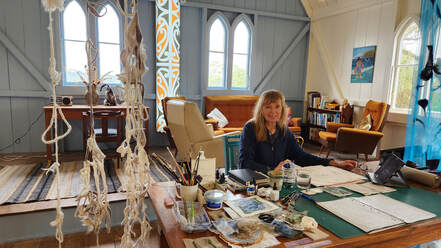
Reflections & Learnings
I came to Rawene feeling like a ‘blow in’*. It took all of five minutes to reevaluate and settle in to what would be home for the month of October. The studio living quarters emit a warm, homely vibe where all creature comforts have been thought of. The Church offers space, literally and figuratively for creative expansion.
As weeks ramble along with the ebb and flow of the tide, each day brings a deepening respect and connection to whenua and the community. Removed from the hustle of city life, a sense of peace slowly descends. I experienced time differently, recognising why folk come to Hokianga and never leave. Here the spirit of the 60’s remains alive – hippie dreams and ideals. A belief in freedom and a sense of togetherness. People who have fought hard with placards and protests - believing in causes and instigating change for the benefit of the local environment and its inhabitants. A community that is all about its people, diverse as they may be. There is a connective thread – love of Hokianga and a desire to protect the essential spirit of this place.
Spring signals renewal with manuka flowering profusely and sparrows mating madly, balancing on the rusty spouting next door. I gaze out the dining room window, mesmerised by the expansive view where I watch the sunrise, and the sun set. My intentions for my art practice rely heavily on nature, and here there is plenty to observe and connect with. I stitch and stain textile samples while listening to podcasts on regenerative farming, seed saving, permaculture and soil health. I weave in the insights, along with shapes and patterns I notice on morning walks. The learning for me is embedded in each piece, with acknowledgment and connection to this place and my desire to make a difference to wider ecological regeneration. The slower pace matches the slowness of stitching. I can’t make art hurriedly; it requires gestation and reflection.
Meeting friendly locals and artists over cups of tea and scones was enlightening and entertaining. The most memorable friendship made has been with the extraordinary writer, teacher, eco-feminist, mum, great grandmother, gardener, champion for change, Janine McVeagh. I invited her to collaborate with me on a series, Seeds of Hope. I have chosen five native trees to illustrate, while Janine is currently writing a poem for each. I will then write the words on each corresponding artwork in patterns relating to the species.
The influence of nature, the rhythm of the tide, Hokianga, the people, have left a lasting impression on me. A huge thank you to Lynn and Linda for this fabulous opportunity.
*An Irish term for a person who moves and lives in an area they were not born and reared in.
I came to Rawene feeling like a ‘blow in’*. It took all of five minutes to reevaluate and settle in to what would be home for the month of October. The studio living quarters emit a warm, homely vibe where all creature comforts have been thought of. The Church offers space, literally and figuratively for creative expansion.
As weeks ramble along with the ebb and flow of the tide, each day brings a deepening respect and connection to whenua and the community. Removed from the hustle of city life, a sense of peace slowly descends. I experienced time differently, recognising why folk come to Hokianga and never leave. Here the spirit of the 60’s remains alive – hippie dreams and ideals. A belief in freedom and a sense of togetherness. People who have fought hard with placards and protests - believing in causes and instigating change for the benefit of the local environment and its inhabitants. A community that is all about its people, diverse as they may be. There is a connective thread – love of Hokianga and a desire to protect the essential spirit of this place.
Spring signals renewal with manuka flowering profusely and sparrows mating madly, balancing on the rusty spouting next door. I gaze out the dining room window, mesmerised by the expansive view where I watch the sunrise, and the sun set. My intentions for my art practice rely heavily on nature, and here there is plenty to observe and connect with. I stitch and stain textile samples while listening to podcasts on regenerative farming, seed saving, permaculture and soil health. I weave in the insights, along with shapes and patterns I notice on morning walks. The learning for me is embedded in each piece, with acknowledgment and connection to this place and my desire to make a difference to wider ecological regeneration. The slower pace matches the slowness of stitching. I can’t make art hurriedly; it requires gestation and reflection.
Meeting friendly locals and artists over cups of tea and scones was enlightening and entertaining. The most memorable friendship made has been with the extraordinary writer, teacher, eco-feminist, mum, great grandmother, gardener, champion for change, Janine McVeagh. I invited her to collaborate with me on a series, Seeds of Hope. I have chosen five native trees to illustrate, while Janine is currently writing a poem for each. I will then write the words on each corresponding artwork in patterns relating to the species.
The influence of nature, the rhythm of the tide, Hokianga, the people, have left a lasting impression on me. A huge thank you to Lynn and Linda for this fabulous opportunity.
*An Irish term for a person who moves and lives in an area they were not born and reared in.
Garth Maxwell
18 to 29 September 2023 & 3 to 17 December 2023
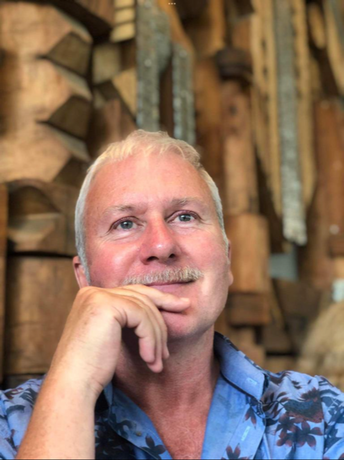
Maxwell began working in commercial film industry on the 1984 feature Other Halves. During the 1980s, Maxwell had the opportunity to assist Peter Wells and Stewart Main in their editing suite.[7]
He had a big interest in film making, especially when he was in university, where he had made Super 8 films. The third short film he made was called Tandem, a music-heavy short film. It won the GOFTA award for the best short of 1987. In 1988, with funding from TVNZ, Maxwell directed Beyond Gravity, a love story between two men, an astronomy-obsessed Kiwi and a part Italian. This was Maxwell's first gay film. Garth and his co-writer Graham Adams won the best screenplay prize at a French film festival that same year, where they won $13,000.[7]
His first feature film was a drama, Jack Be Nimble, which he made in 1993. The film was about traumatized twins who reunite to find their birth parents after being separated at birth. The film won the award for best screenplay at Portugal’s Fantasporto film festival.[7]
Maxwell was one of the directors on the Xena: Warrior Princess and Hercules: The Legendary Journeys television series. He became one of the more profound Kiwi directors for these television shows.[8] In 1998, Maxwell directed and co-wrote When Love Comes Along. In 2007 he created the TV series Rude Awakenings, directing many of its episodes.
He had a big interest in film making, especially when he was in university, where he had made Super 8 films. The third short film he made was called Tandem, a music-heavy short film. It won the GOFTA award for the best short of 1987. In 1988, with funding from TVNZ, Maxwell directed Beyond Gravity, a love story between two men, an astronomy-obsessed Kiwi and a part Italian. This was Maxwell's first gay film. Garth and his co-writer Graham Adams won the best screenplay prize at a French film festival that same year, where they won $13,000.[7]
His first feature film was a drama, Jack Be Nimble, which he made in 1993. The film was about traumatized twins who reunite to find their birth parents after being separated at birth. The film won the award for best screenplay at Portugal’s Fantasporto film festival.[7]
Maxwell was one of the directors on the Xena: Warrior Princess and Hercules: The Legendary Journeys television series. He became one of the more profound Kiwi directors for these television shows.[8] In 1998, Maxwell directed and co-wrote When Love Comes Along. In 2007 he created the TV series Rude Awakenings, directing many of its episodes.
Residency Reflections and Learnings
I appreciated the austerity of the interior of the Church, Very elemental. Wind rain and birdsong were the forces from outside, all had a beautiful echo in my writing. I was doing a piece that was not realism, but a kind of heightened romantic style, gothic and surreal, and the combination of the large echo chamber of the hall, and its antique materials, and the purity of the arches overhead, lifted me up, away from concerns of a domestic or ordinary kind, and allowed my thoughts to spiral toward the intense and imaginary. The time my project is set in, is a sort of timeless contemporary that feels more Victorian than modern. The interweaving arches like clasped fingers above me drew me upward. I alternated between sitting at the window facing up the harbour, to do my actual writing but when I needed to regularly sort out scene order, I turned to the big table in the middle of the hall, and rearranged cards with scene outlines on them. That was my method, and two weeks flew. I met with friends down at the harbour from time to time but I was careful to keep mostly to myself, and I feel that I was given an amazing chance to make real headway on this idea that has been haunting me for two years, by protecting myself from outside influences. No TV no radio, sometimes music but mostly silence. Up early, and to bed in the comfort of the restored residence when night fell. Snoozes on the couch when I was needing to recharge. What a good experience it was. I got my momentum back.
I appreciated the austerity of the interior of the Church, Very elemental. Wind rain and birdsong were the forces from outside, all had a beautiful echo in my writing. I was doing a piece that was not realism, but a kind of heightened romantic style, gothic and surreal, and the combination of the large echo chamber of the hall, and its antique materials, and the purity of the arches overhead, lifted me up, away from concerns of a domestic or ordinary kind, and allowed my thoughts to spiral toward the intense and imaginary. The time my project is set in, is a sort of timeless contemporary that feels more Victorian than modern. The interweaving arches like clasped fingers above me drew me upward. I alternated between sitting at the window facing up the harbour, to do my actual writing but when I needed to regularly sort out scene order, I turned to the big table in the middle of the hall, and rearranged cards with scene outlines on them. That was my method, and two weeks flew. I met with friends down at the harbour from time to time but I was careful to keep mostly to myself, and I feel that I was given an amazing chance to make real headway on this idea that has been haunting me for two years, by protecting myself from outside influences. No TV no radio, sometimes music but mostly silence. Up early, and to bed in the comfort of the restored residence when night fell. Snoozes on the couch when I was needing to recharge. What a good experience it was. I got my momentum back.
Julian Noel
28 July - 3 September 2023
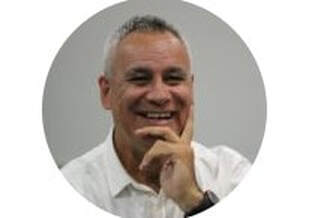
Julian Noel is a writer, poet, actor, performer, entrepreneur, and lover of words inherited from his mother, Eve Patuawa Nathan, one of the first Māori women to have a book of her poetry published. Julian trained as an actor at the VCA in Melbourne, Australia, and specialized in creating his own works. He has experience working on stage, television, and film. He also studied for an English degree with a focus on creative writing. He is currently writing a series of stories about growing up in Aotearoa and creating a one-man play.
"My time will be spent on two inter-linked projects, a book and a play. A book of stories, working title: 'The Awful Grace of God'. The title is based upon a quote of the Greek Poet/tragedian Aeschylus, 'He who learns must suffer. And even in our sleep pain that cannot forget falls drop by drop upon the heart, and in our own despair, against our will, comes wisdom to us by the awful grace of God'. Aeschylus The stories are an exploration of the gifts passed down through the generations including both traumatic and sacred gifts bequeathed to us by our ancestors. The one person play is entitled BONES, based upon the stories. And is an exploration of what we carry in our bones".
"My time will be spent on two inter-linked projects, a book and a play. A book of stories, working title: 'The Awful Grace of God'. The title is based upon a quote of the Greek Poet/tragedian Aeschylus, 'He who learns must suffer. And even in our sleep pain that cannot forget falls drop by drop upon the heart, and in our own despair, against our will, comes wisdom to us by the awful grace of God'. Aeschylus The stories are an exploration of the gifts passed down through the generations including both traumatic and sacred gifts bequeathed to us by our ancestors. The one person play is entitled BONES, based upon the stories. And is an exploration of what we carry in our bones".
Residency Reflections and Learnings
What a wonderful venue. Spacious, restful, warm and safe from the winds and rain. A wonderful 6 weeks of writing, performing, meeting the local arts community and beyond. This time and venue allowed me to connect deeply with the creative urges and what is seeking to emerge from within the womb of creativity.... it was exciting, frightening and ultimately rewarding.
On my final night I performed BONES to the local men's group. The group was started by a local man with a heart of gold and a dark past. It is 6 o'clock, men are arriving in dribs and drabs. As everyone arrives the Maori tradition of introducing yourself to everyone in the room, ensues. Handshakes and hongis (the gentle touching of the noses). There is an air of discomfort. People who know one another group and fall into easy conversation.... for those of us who don't know anyone there is the obligatory staring into space or down at the floor. I scan the room. Most of the men are Maori and poor. There are a couple of well heeled Pakeha man, who shuffle off into a corner. One person in particular catch my attention, a wiry Māori man, as he introduces himself he deliberately avoids the traditional hongi, offering a stilted, awkward hug instead. His eyes are dark and will not meet mine. His shoulders are stooped. Most of his top teeth are missing. He has the aura of sad defeat. I am feeling reticent about my performance. The themes in the play will echo the upbringings of these men... and I wonder if this is a good idea.
Rawene is a place of great natural beauty, a thin peninsula pressing into the glassy smooth waters of the Hokianga harbour and ringed by the greenest of hills. It is a warm-hearted community and they rallied whilst I was on this 5 week creative retreat. There were poetry and songwriting evenings, scone and chat afternoons, music and scones gatherings, we also did a 'global' broadcast in honour of National Poetry Day in New Zealand... and a couple of performances of my play BONES. I found it a challenging place to be. Against the backdrop of nature's beauty and serenity, the foreground is one of Poverty, meth addiction and social inequity. All brought into sharp relief with the impending elections.... and knowing nothing will change for most people here. I felt I was in the land that time forgot. No political advantage to changing the lives’ of these people. Distressing.
Still, hope springs eternal in the human heart.
My host welcomes me in te reo (the Māori language) which I do not understand. There is warm applause. I step forward and start to introduce myself... " My mother comes from this area, she worked in the local hospital, she was one of the first Māori women to have a book of her poetry published, and she wrote about Rawene". I feel compelled to pause. In the silence, my judgments of those present and any sense of separation falls away. A freshness fills the air. I continue, " I really want to thank you for coming along this evening, it really means a lot to me". At this, the wiry toothless Māori jumps to his feet, "Looks me straight in the eye saying" No. Thank you for coming to be with us".
The play begins. They ride every bump, shudder and joke. At the conclusion of the play my toothless friend leaps to his feel in full blown applause. We drink tea and share scones together. One of the reserved pakeha men approaches me saying, "Thank you. That was my life you represented. My father spent years molesting my sisters and was put away".
We are all fighting silent battles. Be kind.
What a wonderful venue. Spacious, restful, warm and safe from the winds and rain. A wonderful 6 weeks of writing, performing, meeting the local arts community and beyond. This time and venue allowed me to connect deeply with the creative urges and what is seeking to emerge from within the womb of creativity.... it was exciting, frightening and ultimately rewarding.
On my final night I performed BONES to the local men's group. The group was started by a local man with a heart of gold and a dark past. It is 6 o'clock, men are arriving in dribs and drabs. As everyone arrives the Maori tradition of introducing yourself to everyone in the room, ensues. Handshakes and hongis (the gentle touching of the noses). There is an air of discomfort. People who know one another group and fall into easy conversation.... for those of us who don't know anyone there is the obligatory staring into space or down at the floor. I scan the room. Most of the men are Maori and poor. There are a couple of well heeled Pakeha man, who shuffle off into a corner. One person in particular catch my attention, a wiry Māori man, as he introduces himself he deliberately avoids the traditional hongi, offering a stilted, awkward hug instead. His eyes are dark and will not meet mine. His shoulders are stooped. Most of his top teeth are missing. He has the aura of sad defeat. I am feeling reticent about my performance. The themes in the play will echo the upbringings of these men... and I wonder if this is a good idea.
Rawene is a place of great natural beauty, a thin peninsula pressing into the glassy smooth waters of the Hokianga harbour and ringed by the greenest of hills. It is a warm-hearted community and they rallied whilst I was on this 5 week creative retreat. There were poetry and songwriting evenings, scone and chat afternoons, music and scones gatherings, we also did a 'global' broadcast in honour of National Poetry Day in New Zealand... and a couple of performances of my play BONES. I found it a challenging place to be. Against the backdrop of nature's beauty and serenity, the foreground is one of Poverty, meth addiction and social inequity. All brought into sharp relief with the impending elections.... and knowing nothing will change for most people here. I felt I was in the land that time forgot. No political advantage to changing the lives’ of these people. Distressing.
Still, hope springs eternal in the human heart.
My host welcomes me in te reo (the Māori language) which I do not understand. There is warm applause. I step forward and start to introduce myself... " My mother comes from this area, she worked in the local hospital, she was one of the first Māori women to have a book of her poetry published, and she wrote about Rawene". I feel compelled to pause. In the silence, my judgments of those present and any sense of separation falls away. A freshness fills the air. I continue, " I really want to thank you for coming along this evening, it really means a lot to me". At this, the wiry toothless Māori jumps to his feet, "Looks me straight in the eye saying" No. Thank you for coming to be with us".
The play begins. They ride every bump, shudder and joke. At the conclusion of the play my toothless friend leaps to his feel in full blown applause. We drink tea and share scones together. One of the reserved pakeha men approaches me saying, "Thank you. That was my life you represented. My father spent years molesting my sisters and was put away".
We are all fighting silent battles. Be kind.
Tanya Batt
- 26 June - 25 July 2023
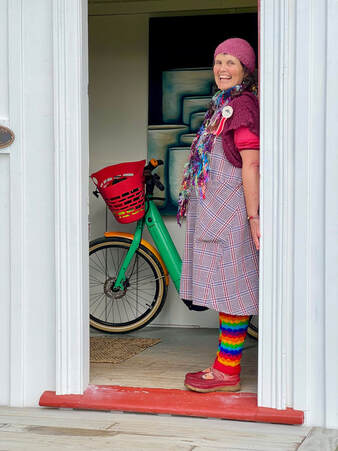
I have long had a love of the Hokianga coupled with an interest in 19th century New Zealand history and our iconic wooden churches. In 2018 I developed a piece of storytelling theatre in partnership with my musician husband, Peter Forster, around the story of Mary Bumby, the sister of John.H.Bumby who was the appointed superintendent missionary at the Māngungu Mission on the Hokianga. Mary Bumby is credited with bringing Apis Mellifera, the honey bee to Aotearoa.
Her story interested me as a gardener/bee keeper and as a woman – and I used it as a vehicle for exploring the human relationship with not only the honey bee but the natural world in general. The work I am focusing on while in residence is more educational in nature though similarly concerned with the natural world. I am working on two educational resources for teachers. Seasonal Storytelling- a calendar of story, drama and song is a practical collection of ideas for realigning the inherited European calendar with our seasonal celebrations (e.g. taking spring festivals out of Autumn) using the expressive arts. Likewise, Growing Stories – the stories of our food and the land it grows on is also pragmatic in nature and based on two years of work with the tamariki of Waiheke Primary school in their māra/garden. At the heart of both pieces of work is storytelling.
Residency Reflections and Learnings
Winter in the not so winterless north.
I can’t think of a better way to spend winter than sitting in a church that overlooks an ever changing harbour, writing.
A church can be an expansive inward space and winter the season of contemplation. Working on a book that encourages teachers to embrace the lessons of the seasons during Pūanga/Matariki added an additional depth to the project.
While I was deeply satisfied to complete the task at hand, I did wonder what it would be like to come into the space without an agenda, to simply create from the experience of habitation. To listen and take inspiration from the whenua that the building sits on, the trees turned timber that form the body of the church and and the resonance of human murmuring seeking to connect with something greater than our small but cherished selves.
It being a Wesleyan church and the oldest in Rawene, it was wonderful to share our performance piece, ‘Mary Bumby’s Hive of Story’ as part of the residency, given the Wesleyan history of the area and that the Hokianga was first home of the honey bee in Aotearoa.
Ngā mihi nui for the opportunity and for the manaakitanga shown to me by the community of the Hokianga.
Winter in the not so winterless north.
I can’t think of a better way to spend winter than sitting in a church that overlooks an ever changing harbour, writing.
A church can be an expansive inward space and winter the season of contemplation. Working on a book that encourages teachers to embrace the lessons of the seasons during Pūanga/Matariki added an additional depth to the project.
While I was deeply satisfied to complete the task at hand, I did wonder what it would be like to come into the space without an agenda, to simply create from the experience of habitation. To listen and take inspiration from the whenua that the building sits on, the trees turned timber that form the body of the church and and the resonance of human murmuring seeking to connect with something greater than our small but cherished selves.
It being a Wesleyan church and the oldest in Rawene, it was wonderful to share our performance piece, ‘Mary Bumby’s Hive of Story’ as part of the residency, given the Wesleyan history of the area and that the Hokianga was first home of the honey bee in Aotearoa.
Ngā mihi nui for the opportunity and for the manaakitanga shown to me by the community of the Hokianga.
Jason Burgess
12 - 25 June 2023
|
A creative content maker who loves working on the fly, moving light and fast. I photograph, write and often doodle (it curbs my thinking out loud.) I am curious and passionate, have catholic tastes, an into it attitude and a thirst for the arts and travel. |
When applying for any arts opportunity I often feel like an imposter. At best I am a capricious archivist of artists and unreliable patron of their output. But in this instance I have been given an opportunity to forward a biographical project based on the life and work of 'outlier' painter / ceramicist Tony Johnston. My goal for a residency in Rawene is that it will provide a place where I can distil the project to date; hone in, collate and construct a narrative for the work, which at present, feels as unwieldy as one of Tony's paintings might seem to a new viewer of his work. Personally, I find the Hokianga is a content rich and visually inspiring locale. I would like to think that in between hours spent with Tony's project I can get out and explore nearby environs with my camera and perhaps unearth some interesting stories from local characters and places. |
Residency Reflections and Learnings
It doesn’t matter how much of a sanctuary I make my writing station at home base, there is always the to-do list of domestic distractions playing around at the back of the mind.
The Church was an excellent opportunity to step away from such diversions and focus in on my task at hand IE to find some order to the previously nebulous ideas i held around my Tony Johnston book project.
The first week in Rawene for me really was a defrag’ time; pulling away from my city busy-ness; settling into the rhythm of the tides and asking questions of myself.
Week two, the silt settled. I got more grounded and the project started to take some form from the amorphous sludge I had arrived with.
Personally speaking, another week at the residence may of been of value to keep the focus. That said, at least now I have a direction and momentum to carry things forward.
Rawene is a great place to meditate on whatever it is that needs one’s attention. There is enough action around the gallery/wharf area, if folk need the stimulus of fellow humans: real characters and good coffee but the sanctuary of the Church provides the perfect space to contemplate & create. Views, sun and quiet.
It doesn’t matter how much of a sanctuary I make my writing station at home base, there is always the to-do list of domestic distractions playing around at the back of the mind.
The Church was an excellent opportunity to step away from such diversions and focus in on my task at hand IE to find some order to the previously nebulous ideas i held around my Tony Johnston book project.
The first week in Rawene for me really was a defrag’ time; pulling away from my city busy-ness; settling into the rhythm of the tides and asking questions of myself.
Week two, the silt settled. I got more grounded and the project started to take some form from the amorphous sludge I had arrived with.
Personally speaking, another week at the residence may of been of value to keep the focus. That said, at least now I have a direction and momentum to carry things forward.
Rawene is a great place to meditate on whatever it is that needs one’s attention. There is enough action around the gallery/wharf area, if folk need the stimulus of fellow humans: real characters and good coffee but the sanctuary of the Church provides the perfect space to contemplate & create. Views, sun and quiet.
Carolyn Lye and Elsa Lye
14 May to 10 June 2023
Carolyn and Elsa (daughter and mother) are valuing this opportunity to spent time devoted just to their art practice and especially happy to have art time together for the first time . Goodness knows what new and exciting work will emerge!
(Note: Carolyn is resident in the church and Elsa accommodated at the Rawene Motor camp)
(Note: Carolyn is resident in the church and Elsa accommodated at the Rawene Motor camp)
|
Elsa Lye “ my creative process or what makes me tick, is still a puzzle, a magic mystery that enthrals me. I am pulled and pushed to express life as it unfolds. What I feel and what I see, the place of spirit in nature life and art. Then trust the intuitive process to tell its story.” I draw and paint directly along the Wild West coast, the challenge to catch these beautiful spaces draws me back time after time. My studio paintings are abstract internalised expressions of life. My clay sculptures often relate to human environments and concerns. Residency Reflections and Learnings In my residency application I remember writing of the need for World change, such a huge question. As I sit and thinks, I realise the change has been me. I have reconnected to my artist self which had wandered off in the hustle of everyday life. It’s a conscious revitalised change that gives me energy and confidence to skip and dance with my artist, learn new steps to old rhythms. Over the years I have ( Im a Great Granma) worked in many ways and mediums to express ideas that have spiked my imagination. Here in Rawene, Carolyn and I worked intently in our own way, using every inch of this beautifully restored Old Church. Our exhibition just 3 weeks away. No Pressure. On reflection as a painter working beside Carolyn, who weaves magic with natural and recycled materials. I only had a vague idea how our exhibition would look, feel or tell its story. It wasn’t until working with curator Lynsey Evans that we started to see our work as an installation and just how beautiful the conversation. This residency has been a dream come true, thank you Carolyn, strengthening my artist backbone, my confidence to the gestalt strength of family and community. Thank you, Lynn Lawton for your kindness, your support both professional and personal, for your vision to promote art in all its guises. |
Carolyn Lye
Based near Karetu, Northland, Carolyn is a fibre artist who weaves and works in natural materials. She is surrounded by the rural landscape and flora and is involved with the community of artists in the area. She enjoys collecting what she has found randomly and has an intuitive, primal response to her materials, be they kelp, fishing rope, roots, nuts, shells, harakeke, pumice, cabbage tree and flowers. Carolyn works to blend an unexpected variety of materials to create items of beauty. Her devotion to joining, blending and weaving items together gives integrity to work that is greater than the materials; it expresses her philosophy ‘we only think we are separate’ (Witi Ihimaera – Rope of Man).
Residency Reflections and Learnings
Residency for me has meant realising a dream of creating alongside my Mother toward an exhibition and spending precious time together. The church is an incredibly beautiful facility to work and reside in. It is warm and comfortable. I felt safe during my stay. Thank you. It takes time to settle in so I was compelled to start with familiar forms of lei and sedge grass Oi Oi girls until I found my making rhythm. Then over the second week new works emerged – giving me some confidence moving towards our exhibition at No 1 Parnell. Having a deadline fueled us making us work and also standby what we created very quickly!! I wonder if some time between residency and exhibiting might be productive and enjoyable for future resident artists. I have gained so much through this experience. Thank you Linda and Lynn its been fantastic. Your wrap around support and service ism incredible
Based near Karetu, Northland, Carolyn is a fibre artist who weaves and works in natural materials. She is surrounded by the rural landscape and flora and is involved with the community of artists in the area. She enjoys collecting what she has found randomly and has an intuitive, primal response to her materials, be they kelp, fishing rope, roots, nuts, shells, harakeke, pumice, cabbage tree and flowers. Carolyn works to blend an unexpected variety of materials to create items of beauty. Her devotion to joining, blending and weaving items together gives integrity to work that is greater than the materials; it expresses her philosophy ‘we only think we are separate’ (Witi Ihimaera – Rope of Man).
Residency Reflections and Learnings
Residency for me has meant realising a dream of creating alongside my Mother toward an exhibition and spending precious time together. The church is an incredibly beautiful facility to work and reside in. It is warm and comfortable. I felt safe during my stay. Thank you. It takes time to settle in so I was compelled to start with familiar forms of lei and sedge grass Oi Oi girls until I found my making rhythm. Then over the second week new works emerged – giving me some confidence moving towards our exhibition at No 1 Parnell. Having a deadline fueled us making us work and also standby what we created very quickly!! I wonder if some time between residency and exhibiting might be productive and enjoyable for future resident artists. I have gained so much through this experience. Thank you Linda and Lynn its been fantastic. Your wrap around support and service ism incredible
Bert Van Dijk
9 April to 10 May 2023
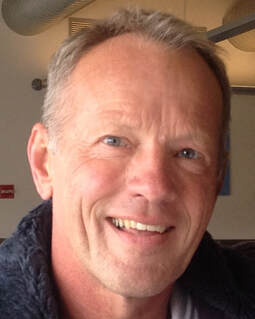
Residency Reflections and Learnings
After working for more than 30 years as a performing artist, I have the last few years turned to visual art, working with acrylic, oil, ink, charcoal, pastels and collage on canvas and wood panels.
For my work, I find inspiration in the archetypal dimensions of nature (the gods), the moods of land- and seascapes, and the beauty of the male body frozen in motion or emotion.
This Hokianga residency has given me an opportunity to explore in colours, composition and expression, the contours, atmosphere and spirit of this extraordinary area. I have also found inspiration at some of the pre-European narratives, particularly those that explain the original names of the Hokianga: Hokianga whakapau karakia (Hokianga that exhausts karakia) and Te Puna i te Ao Mārama (the spring of the world of light).
It was interesting and unexpected to see whales and whale related themes emerging in my work during my residency.
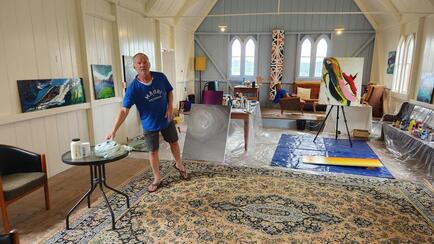
Exhibition title: Breaching the Surface
Breaching the Surface refers to what I believe is a mission of the artist, to present not just the outer form of something but also express the mood, feeling or dramatic essence of a place or subject.
The act of breaching refers to a process of getting through, breaking out, cracking up and penetrating into, as a metaphor for expanding our horizons, an act that requires an almost violent energy to overcome certain limitations.
During my residency, whales – champions of breaching – have entered my work, both in the shapes of the Hokianga landscape and as protagonists in some of the pre-European Māori stories of the area.
Breaching the Surface refers to what I believe is a mission of the artist, to present not just the outer form of something but also express the mood, feeling or dramatic essence of a place or subject.
The act of breaching refers to a process of getting through, breaking out, cracking up and penetrating into, as a metaphor for expanding our horizons, an act that requires an almost violent energy to overcome certain limitations.
During my residency, whales – champions of breaching – have entered my work, both in the shapes of the Hokianga landscape and as protagonists in some of the pre-European Māori stories of the area.
Brenda Moir
4 March - 3 April 2023
Residency Reflections and Learnings
My time spent in the Rawene Church as a resident artist in March 2023 was absolutely wonderful!
I was able to concentrate on creating a cohesive body of painting works without restrictions on time, space or outside commitments.
There was plenty of room to spread out and work on several pieces at the same time and not having to “wait for paint tot dry” enabled greater productivity. The ability to to watch paintings become completed-from a distance, through different light phases and neighbouring other works was a real treat that I have never had before.
The whole experience was extremely gratifying, extremely productive and I was very pleased with the creative outcome.
The living area was so very comfortable and compact making life easy, relaxed and separated from the painting area ( the church).
My experience of meting, joining in with and living amongst the village of Rawene was mostly rewarding, educational and all encompassing, they made me feel very special. I give my sincere gratitude to Linda and Lynn for allowing me to partake in this Residency and adding a fabulous, happy and fulfilling experience to my life!
My time spent in the Rawene Church as a resident artist in March 2023 was absolutely wonderful!
I was able to concentrate on creating a cohesive body of painting works without restrictions on time, space or outside commitments.
There was plenty of room to spread out and work on several pieces at the same time and not having to “wait for paint tot dry” enabled greater productivity. The ability to to watch paintings become completed-from a distance, through different light phases and neighbouring other works was a real treat that I have never had before.
The whole experience was extremely gratifying, extremely productive and I was very pleased with the creative outcome.
The living area was so very comfortable and compact making life easy, relaxed and separated from the painting area ( the church).
My experience of meting, joining in with and living amongst the village of Rawene was mostly rewarding, educational and all encompassing, they made me feel very special. I give my sincere gratitude to Linda and Lynn for allowing me to partake in this Residency and adding a fabulous, happy and fulfilling experience to my life!
Geoff Clendon
7 Oct - 5 Nov 2022
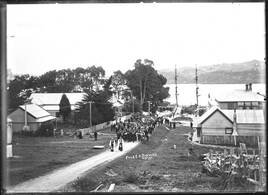
The name ‘The Dog Tax War’ describes an armed uprising of Te Mahurehure of Waima against the government in 1898. Although there were comical aspects of the uprising, it was in reality a very near tragedy – the outcome of smouldering resentment against bad laws, broken promises, and the steady undermining of Māori mana. It remains a potent symbol of the ongoing struggle of relationship amongst Māori and the Crown, and Māori and Pākehā. Sparks from this incident burn into the present and remain in the memories of affected communities.
The Dog Tax War is intimately connected to Geoff's family’s history. His tūpuna were protagonists on both sides. His whakapapa includes: the Clendons of Rawene and Muriwai of Utakura.
The Dog Tax War was an extraordinary affair that deserves to be re-visited in an inventive theatrical production. His long-term plan is to open the first production of the play in Rawene, bringing the story home to the community from which it sprang.
The Dog Tax War is intimately connected to Geoff's family’s history. His tūpuna were protagonists on both sides. His whakapapa includes: the Clendons of Rawene and Muriwai of Utakura.
The Dog Tax War was an extraordinary affair that deserves to be re-visited in an inventive theatrical production. His long-term plan is to open the first production of the play in Rawene, bringing the story home to the community from which it sprang.
Gabrielle BelzJune 2015Printmaker and artist Gabrielle Belz presented a collection of works derived from her observations, thoughts and experiences over the 10 week residency in Rawene. This first residency was prior to our securing the church and Gabrielle's residency was at a local accommodation and she worked in the Waka Gallery at No 1 Parnell.
'‘The Hokianga landscape, with thrusting hills and deep valley clefts, constant cloud changes, rainbows, mist, rain and light, were immediate impressions. Smiling friendliness of the community coupled with the ‘well, who is she?’ Hearing local histories began to colour the way I saw the present landscape and gave an insight into the possible forming of today’s community. ‘ Gabrielle of Ngapuhi and Te Atiawa descent, undertook her practice in the Waka Gallery at No 1 Parnell where she also ran some very popular workshops. |

